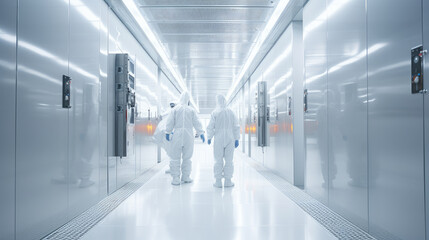Introduction
In industries that depend on ultra-pure environments, such as pharmaceuticals, biotechnology, electronics, and aerospace, clean rooms play a vital role by providing a highly controlled atmosphere essential for product quality and safety. Within these controlled environments, cooling systems are fundamental in maintaining stable temperature and humidity levels, ensuring contaminant-free air, and preventing any fluctuations that could impact sensitive processes or equipment. Unlike typical HVAC systems, cooling solutions for clean rooms must meet exceptionally high standards for air quality, reliability, and environmental precision. This article explores the unique requirements and design considerations for clean room cooling systems, highlighting how they support critical processes by ensuring stringent environmental stability.
Strict Temperature and Humidity Control
- Clean rooms often require very narrow temperature and humidity ranges, with fluctuations minimized to prevent issues like product instability or process failures. Cooling systems must offer precise control to maintain these conditions continuously.
- Advanced HVAC (heating, ventilation, and air conditioning) systems equipped with sensors and controllers are commonly used to monitor and adjust temperature and humidity levels in real-time.
Air Filtration and Contamination Control
- Air purity is critical in clean rooms. Cooling systems must include HEPA (High-Efficiency Particulate Air) filters, which can capture particles as small as 0.3 microns, to remove contaminants from the air.
- In many cases, ULPA (Ultra-Low Particulate Air) filters, which capture even finer particles, are also used. The cooling system should be compatible with these filters and avoid generating particulates, as any contamination can affect sensitive processes.
Positive and Negative Pressure Maintenance
- Many clean rooms require either positive or negative pressure to prevent cross-contamination. Cooling systems must support these pressure requirements by managing the airflow effectively.
- Positive pressure is often used to keep contaminants out of the clean room, while negative pressure is applied in rooms where contaminants must be contained within the space.
Energy Efficiency and Temperature Stability
- Energy efficiency is a significant consideration, as clean room cooling systems run continuously and can be energy-intensive. Using energy-efficient components such as variable frequency drives (VFDs) and optimized compressors can help reduce operational costs.
- Cooling systems should be designed to maintain temperature stability, especially when cooling loads vary. This is crucial for sensitive equipment and processes that can be impacted by even slight changes in temperature.
Minimizing Vibration and Noise
- Many clean room environments house sensitive equipment that can be affected by vibration and noise. Cooling systems should be designed and installed with features to minimize vibration and sound.
- Specialized mounts, low-vibration components, and sound-dampening materials are often employed to maintain a quiet, stable environment for equipment operation.
Humidity Control and Dehumidification
- In environments like pharmaceutical or semiconductor clean rooms, excess humidity can lead to issues such as microbial growth or equipment corrosion. Cooling systems for these applications often include dehumidification functions.
- Desiccant dehumidifiers or advanced HVAC systems with integrated humidity controls are commonly used to maintain appropriate moisture levels.
Redundancy and Reliability
- Clean rooms are high-stakes environments where system downtime can lead to significant financial loss or compromised product integrity. Redundant cooling systems are often included to ensure constant operation.
- Backup power sources, such as uninterruptible power supplies (UPS), are also incorporated to keep the cooling systems operational in the event of a power failure.
Compliance with Industry Standards
- Many industries require compliance with standards for clean room environments, such as ISO 14644, which specifies classes of air cleanliness, and FDA guidelines for the pharmaceutical industry.
- Cooling systems for clean rooms must meet these regulatory requirements, including documentation and validation to verify that temperature, humidity, and air quality controls meet the necessary standards.
Remote Monitoring and Control
- Real-time monitoring and remote control systems help facility managers track clean room conditions, respond to alarms, and ensure compliance with environmental parameters without physically entering the clean room.
- Internet of Things (IoT) technology and building automation systems (BAS) are often integrated to allow for remote access and control, enhancing convenience and reducing the need for personnel in sensitive areas.
Maintenance and Servicing Accessibility
- Due to strict contamination control, maintenance and servicing must be planned carefully. Cooling systems are often designed to allow access without contaminating the clean room.
- Systems with components that can be serviced outside of the clean room environment, like modular or externally mounted units, help minimize the risk of contamination during maintenance.
Conclusion
n conclusion, cooling systems for clean rooms are engineered to support highly sensitive environments that require exacting control over temperature, humidity, and air purity. Their design and operation go beyond standard HVAC systems, incorporating advanced filtration, vibration reduction, and pressure control to protect processes and products. By understanding and addressing these specialized needs, clean room cooling solutions contribute significantly to maintaining the integrity and compliance of controlled environments. For industries relying on precision and cleanliness, investing in robust, compliant, and efficient cooling systems ensures reliable operations, prevents costly downtime, and helps maintain product quality and safety across various high-stakes applications.

